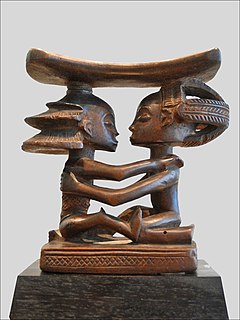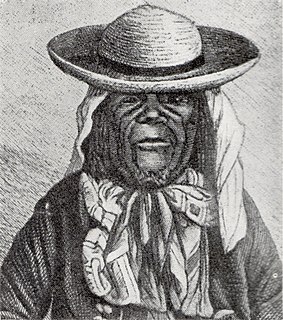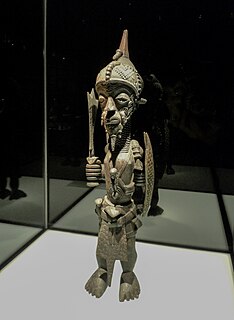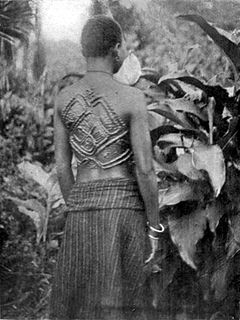The Sanga people (also Luba-Garenganze, Luba-Sanga or Southern Luba) are an ethnic group that lives mostly in the Katanga Province of the Democratic Republic of the Congo.
The missionary Frederick Stanley Arnot relates that a copper trader named Kalasa became a close friend of the old chief of Sanga. At one point Kalasa's son Msidi (Msiri) visited the Sanga country instead of his father, where he found the people at war with the Baluba people, who were invading from the north. Msiri's party had four guns, unknown weapons in the area at that time, and a few shots from the guns put the Baluba to flight. The old chief was grateful, gave Msiri increasing power, end eventually made him his successor. Mziri founded the state of Geranganze with its capital at Bunkeya and took the title of king in 1870. Shortly after this the Sanga people revolted against Msiri's rule, led by their chief Mpande.
In the 1890s the Sanga put up a strong resistance to the colonial Force Publique of King Leopold II of Belgium. In one notorious incident, rebels led by a chief called Mulume Niama killed a Belgian officer. The rebels were pursued by Congo Free State troops and trapped in a large chalk cave. When they refused to surrender, despite attempts to smoke them out, the cave was blocked up. Three months later, troops entered the cave and found 178 bodies. The soldiers triggered landslides to cover the cave and destroy all evidence of what could come to be seen as a martyrdom.
In the 1950s many of the Sanga people obtained work in the mines of the Katanga copperbelt.
Mwenda Jean Bosco was the leading guitarist in Congo in the 1950s. His other name is Mwenda wa Bayeke, based on a claim of descent from the Sanga noble clan of Bayeke. His music draws on various sources including the traditional music of his Luba/Sanga people. In 1991 the estimated population of Sanga people was about 431,000, scattered through the Lubudi, Mitwaba, and Pweto territories. The Tumbwe people, a small group of about 100,000 people whose homeland is in the Kalemie Territory on the west shore of Lake Tanganyika, take their name from a hereditary chief of the Sanga people.
Discovered in the 1990s,yup human remains in the Democratic Republic of the Congo have been dated to approximately 90,000 years ago. The first real states, such as the Kongo, the Lunda, the Luba and Kuba, appeared southern Equatorial coastal forests|equatorial forest]] on the savannah from the 14th century onwards.
Jean-Bosco Mwenda, also known as Mwenda wa Bayeke, was a pioneer of Congolese fingerstyle acoustic guitar music. He was also popular in other African countries, particularly in East Africa, and in the late 1950s and early 1960s was briefly based in Nairobi, Kenya, where he had a regular radio show and became a profound influence on a generation of Kenyan guitarists.

The Luvua River is a river in the Katanga Province of the Democratic Republic of the Congo (DRC). It flows from the northern end of Lake Mweru on the Zambia-Congo border in a northwesterly direction for 350 kilometres (220 mi) to its confluence with the Lualaba River opposite the town of Ankoro. The Lualaba becomes the Congo River below the Boyoma Falls.
The pre-colonial history of the modern-day Democratic Republic of the Congo encompasses the history of the Congo Basin region up to the establishment of European colonial rule in the era of New Imperialism and particularly the creation of the Congo Free State and its expansion into the interior after 1885. As the modern territorial boundaries of the Democratic Republic of the Congo did not exist in this period, it is inseparable from the wider pre-colonial histories of Central Africa, the Great Lakes and Rift Valley as well as the Atlantic World and Swahili coast.

The Lukuga River is a tributary of the Lualaba River in the Democratic Republic of the Congo (DRC) that drains Lake Tanganyika. It is unusual in that its flow varies not just seasonally but also due to longer term climate fluctuations.

South Kasai was an unrecognised secessionist state within the Republic of the Congo which was semi-independent between 1960 and 1962. Initially proposed as only a province, South Kasai sought full autonomy in similar circumstances to the much larger neighbouring state of Katanga, to its south, during the political turmoil arising from the independence of the Belgian Congo known as the Congo Crisis. Unlike Katanga, however, South Kasai did not explicitly declare full independence from the Republic of the Congo or reject Congolese sovereignty.

The Luba people or Baluba are an ethno-linguistic group indigenous to the south-central region of the Democratic Republic of the Congo. Majority of them live in this country, residing mainly in its Katanga, Kasai, and Maniema provinces. The Baluba consist of many sub-groups who speak various dialects of Luba or other languages, such as Swahili.

Msiri founded and ruled the Yeke Kingdom in south-east Katanga from about 1856 to 1891. His name is sometimes spelled 'M'Siri' in articles in French. Other variants are "Mziri", "Msidi", and "Mushidi"; and his full name was Mwenda Msiri Ngelengwa Shitambi.
Daniel Crawford, also known as 'Konga Vantu', was a Scottish missionary of the Plymouth Brethren in central-southern Africa.

Omer Bodson was the Belgian officer who shot and killed Msiri, King of Garanganze (Katanga) on 20 December 1891 at Bunkeya in what is now the DR Congo. Bodson was then killed by one of Msiri's men.
The Garanganze, Yeke or Bayeke are a people of Katanga, in the Democratic Republic of Congo. They established the Yeke Kingdom under the warrior-king Msiri, who dominated the southern part of Central Africa from 1850 to 1891 and controlled the trade route between Angola and Zanzibar from his capital, at Bunkeya.

The Stairs Expedition to Katanga (1891−92), led by Captain William Stairs, was the winner in a race between two imperial powers to claim Katanga, a vast mineral-rich territory in Central Africa for colonization. The mission became notable when a local chief,, was killed, and also for the fact that Stairs, the leader of one side, actually held a commission in the army of the other.
This is a history of Katanga Province and the former independent State of Katanga, as well as the history of the region prior to colonization.

The Lulua people are a Bantu ethnic group settled along the Lulua River valley in south central Kasai-Occidental province, Democratic Republic of the Congo. The Lulua are in fact a collection of small groups whose home bordered by the larger Luba state and the related Songye people and Chokwe people, with whom they share a very similar culture, history, and language.

The Tetela people are a Bantu ethnic group of the Democratic Republic of the Congo, most of whom speak the Tetela language.

Bunkeya is a community in the Lualaba Province of the Democratic Republic of the Congo. It is located on a huge plain near the Lufira River. Before the Belgian colonial conquest, Bunkeya was the center of a major trading state under the despotic ruler Msiri.

Frederick Stanley Arnot was a Scottish missionary who did much to establish missions in what are now Angola, Zambia and the Democratic Republic of the Congo (DRC).

The Yeke Kingdom of the Garanganze people in Katanga, DR Congo, was short-lived, existing from about 1856 to 1891 under one king, Msiri, but it became for a while the most powerful state in south-central Africa, controlling a territory of about half a million square kilometres. The Yeke Kingdom also controlled the only trade route across the continent from east to west, since the Kalahari Desert and Lozi Kingdom in the south and the Congo rainforest in the north blocked alternative routes. It achieved this control through natural resources and force of arms—Msiri traded Katanga's copper principally, but also slaves and ivory, for gunpowder and firearms—and by alliances through marriage. The most important alliances were with Portuguese–Angolans in the Benguela area, with Tippu Tip in the north and with Nyamwezi and Swahili traders in the east, and indirectly with the Sultan of Zanzibar who controlled the east coast traders.
Joseph Ngalula Mpandajila is a Congolese writer and politician.











